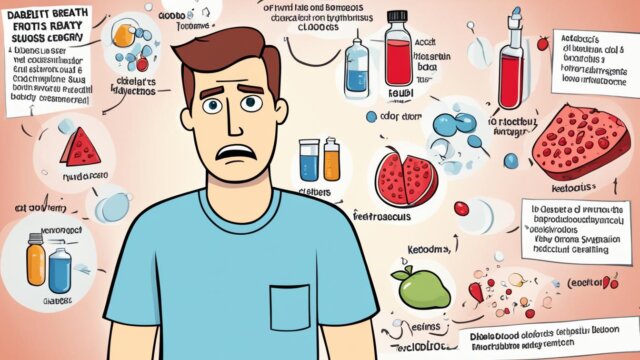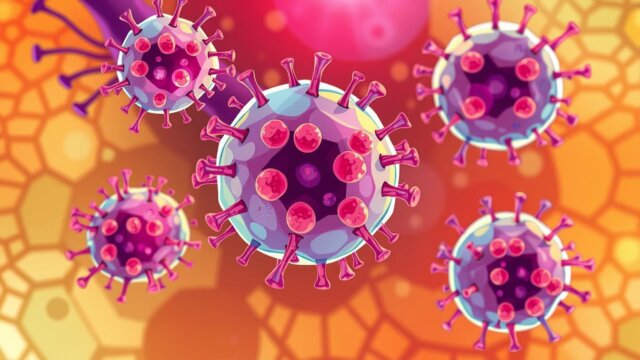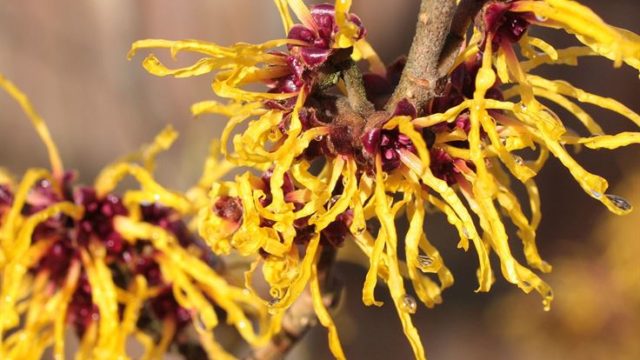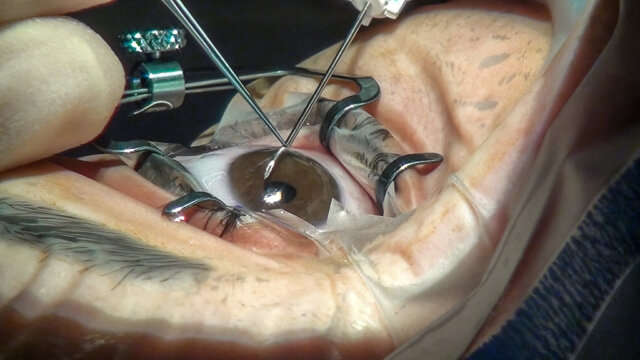FTC disclaimer: This post may contains affiliate links and we will be compensated if you click on a link and make a purchase.
Neurofibromatosis affects about 1 in every 2,500 people. It’s a rare genetic condition that causes tumors on nerve tissues. This condition can greatly impact those who have it. But, with the right care, its effects can be managed.
In this guide, we’ll look at the causes, symptoms, and treatments for this complex disorder. We aim to help you or your loved one manage their health better.
Neurofibromatosis is not just one condition. It’s actually a group of three genetic disorders. They all cause tumors on nerve tissues. Each type has its own causes and symptoms, but all need careful monitoring and special care.
Key Takeaways
- Neurofibromatosis is a rare genetic disorder that causes tumors to grow on nerve tissues throughout the body.
- The most common form, Neurofibromatosis Type 1 (NF1), affects approximately 1 in 2,500 individuals and often presents in childhood.
- Individuals with NF1 may experience a range of symptoms, including skin changes, tumor growth, and increased cancer risk.
- While there is no cure for neurofibromatosis, early diagnosis and proper management of symptoms can greatly improve quality of life.
- Regular monitoring and a multidisciplinary care team are essential for managing the various complications associated with this genetic disorder.
What is Neurofibromatosis?
Neurofibromatosis is not just one disease. It’s a term for three different genetic disorders: NF1, NF2, and schwannomatosis (SWN). NF1 is the most common, affecting about 1 in 2,500 people.
Types of Neurofibromatosis
These three types of neurofibromatosis all grow tumors along nerves. But they have different signs and symptoms. NF1, or von Recklinghausen disease, comes from a gene mutation. NF2 and schwannomatosis are rarer and have different causes and symptoms.
Overview of Neurofibromatosis Type 1
Neurofibromatosis Type 1 (NF1) is the most common, affecting about 1 in 2,500 people. Kids with NF1 often have mild symptoms. It’s usually found by age 10.
People with NF1 have a 50% chance of passing the gene to their kids. Signs include café-au-lait spots, neurofibromas, and freckles in the armpits and groin. They might also have vision problems from optic pathway gliomas.
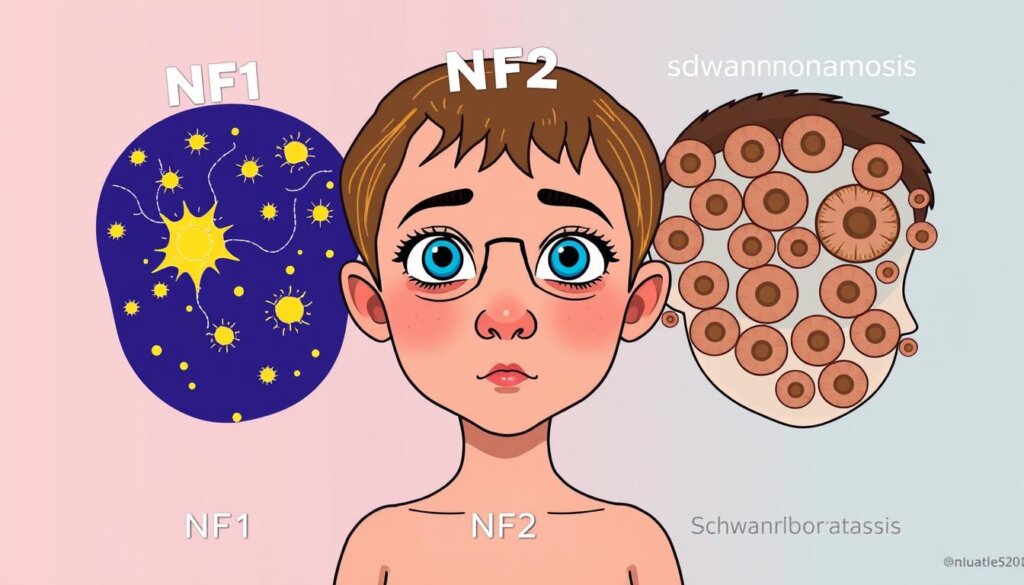
“Neurofibromatosis is one of the most common genetic diseases in the United States.”
Symptoms of Neurofibromatosis
Neurofibromatosis is a complex genetic disorder. It shows a wide range of symptoms, even in the same type. A key sign is more than six café-au-lait skin spots, which can be small or very large.
People with neurofibromatosis may also get soft bumps under the skin called neurofibromas. They might also see tiny growths on their eye’s iris, called Lisch nodules.
Neurofibromatosis can cause more than just visible signs. It can lead to learning disabilities, bone issues, hearing loss, vision problems, and chronic pain. In severe cases, it can cause ADHD, delayed speech, short stature, brain tumors, and more.
The severity of symptoms varies greatly. Some people face many issues, while others might not show any symptoms at all.
Symptom | Prevalence |
|---|---|
Café-au-lait spots | Hallmark sign of neurofibromatosis |
Neurofibromas | Soft, pea-sized bumps under the skin |
Lisch nodules | Tiny growths on the iris of the eye |
Learning disabilities | Common symptom |
Bone deformities | Can occur in neurofibromatosis |
Hearing loss | Potential symptom |
Vision problems | Potential symptom |
Chronic pain | Can be a symptom of neurofibromatosis |
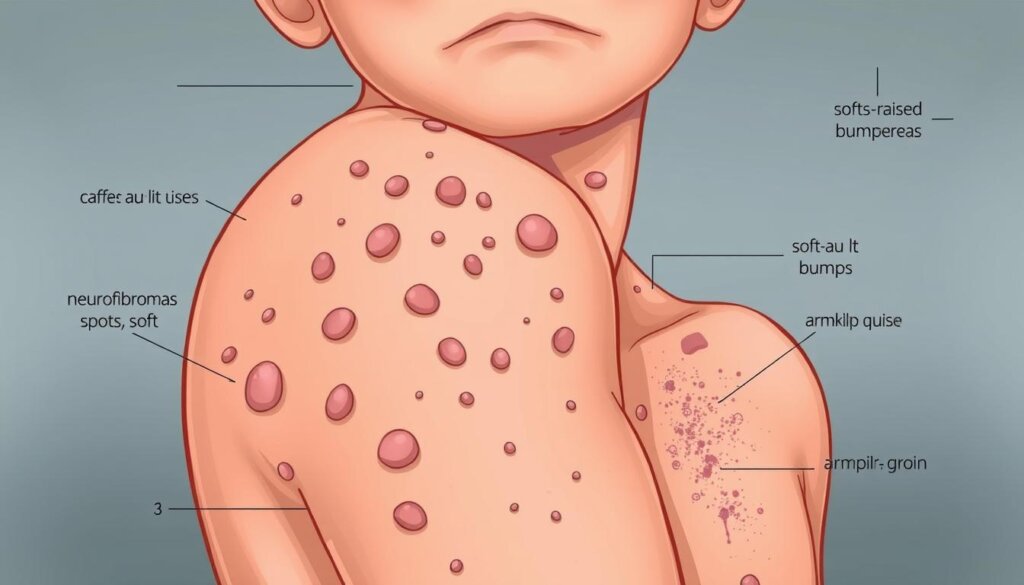
Neurofibromatosis symptoms can change over time. New tumors and complications can appear as the condition gets worse. It’s crucial to watch closely and manage it well.
Signs and Physical Characteristics
One of the most recognizable signs of neurofibromatosis is café-au-lait spots. These are flat, light brown birthmarks that are more than 5 millimeters in children or 15 millimeters in adults. People with neurofibromatosis often have six or more of these spots. Another sign is freckles in the armpits and, which show up between ages 3 and.
While café-au-lait spots and freckles can happen in other conditions like Legius syndrome, they are a big clue for neurofibromatosis.
Neurofibromas and Lisch Nodules
People with neurofibromatosis also get benign tumors called neurofibromas. These are soft, pea-sized bumps that can grow on or under the skin. Sometimes, bigger tumors called plexiform neurofibromas grow, affecting many nerves.
Another sign is Lisch nodules, small growths on the iris of the eye. These are harmless and don’t hurt your vision. But, they help doctors figure out if you have neurofibromatosis.
Neurofibromatosis Type | Prevalence | Key Characteristics |
|---|---|---|
Neurofibromatosis Type 1 (NF1) | 1 in 3,000 births | Café-au-lait spots, neurofibromas, plexiform neurofibromas, Lisch nodules |
Neurofibromatosis Type 2 (NF2) | 1 in 33,000 to 1 in 87,410 births | Schwannomas, meningiomas |
Schwannomatosis | Rare | Severe pain, benign tumors on cranial and spinal nerves |
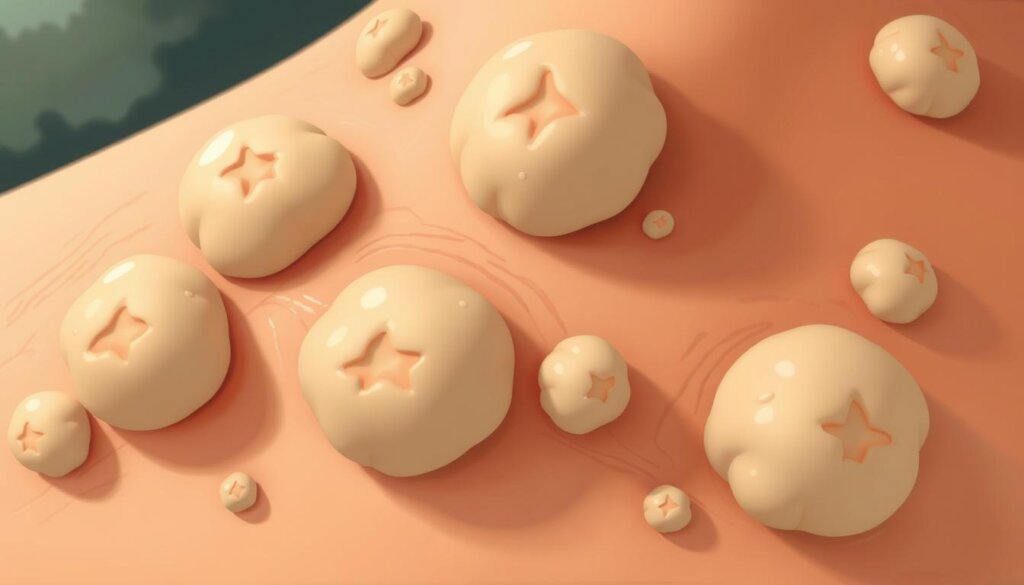
“The presence of café-au-lait spots, neurofibromas, and Lisch nodules, along with other symptoms, is a key indicator of neurofibromatosis.”
Neurofibromatosis and Its Causes
Neurofibromatosis is a genetic condition caused by mutations in specific genes. These genes control cell growth and division. The mutations lead to tumors, called neurofibromas, affecting the nervous system, skin, and other parts of the body.
Genetic Mutations and Inheritance Patterns
The type of neurofibromatosis depends on the gene mutation inherited. NF1 is caused by a mutation in the NF1 gene, producing neurofibromin. NF2 is due to a mutation in the NF2 gene, which codes for merlin. Schwannomatosis, rarer, is linked to mutations in SMARCB1 or LZTR1 genes.
Neurofibromatosis is usually inherited in an autosomal dominant pattern. This means a child has a 50% chance of inheriting the mutation if one parent has it. However, some cases occur without family history, with about half of NF1 cases being spontaneous.
Most schwannomatosis cases happen randomly, with about 85% having no known genetic cause. Symptoms can appear at birth or later, often in the teenage years or around age 30.
People with neurofibromatosis may face a higher risk of certain cancers, like breast cancer and sarcoma. Complications include hearing and vision loss, chronic pain, learning and behavioral issues, and cardiovascular problems. Skin symptoms can also affect self-esteem.
| Key Facts about Neurofibromatosis and Its Causes |
|---|
| – Around half of NF1 cases involve a spontaneous genetic mutation without family history |
| – Approximately 85% of schwannomatosis cases occur randomly without a known genetic cause |
| – Neurofibromatosis symptoms can appear at birth or develop during teenage years or adulthood |
| – Individuals with neurofibromatosis have a higher risk of developing certain cancers |
| – Complications of neurofibromatosis can include hearing loss, vision loss, chronic pain, and more |
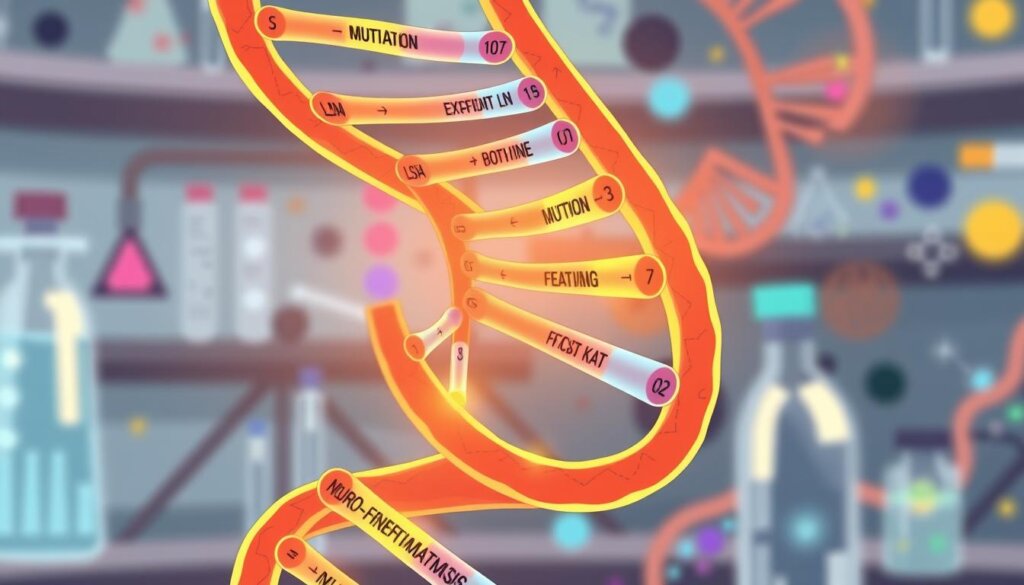
“Neurofibromatosis is a complex genetic condition that can have a significant impact on an individual’s health and well-being. Understanding the underlying genetic causes and inheritance patterns is crucial for effective management and support.”
Risk Factors for Neurofibromatosis
Having a family history is the main risk for neurofibromatosis. It’s an autosomal dominant disorder. This means if one parent has it, their child has a 50% chance of getting it. But, in some cases, the condition happens spontaneously, without family history.
This means the person is the first in their family to have it.
The American Cancer Society says about 5 percent of people with neurofibromatosis get sarcomas. Also, at least 50 percent of NF1 cases come from parents. NF2 and schwannomatosis cases are split, with half inherited and half new mutations.
NF1 is caused by a mutation on chromosome 17. NF2 usually starts in teens or early twenties. Schwannomatosis is linked to mutations in the SMARCB1 or LZTR1 genes.
Having a parent with neurofibromatosis raises your risk. NF1 increases the risk of tumors like schwannomas and gliomas. NF2 raises the risk of meningiomas, vestibular schwannomas, and spinal cord ependymomas.
“Neurofibromatosis is a complex genetic disorder that can have a significant impact on an individual’s health and quality of life. Understanding the risk factors and inheritance patterns is crucial for early detection and appropriate management of this condition.”
Complications Associated with Neurofibromatosis
Neurofibromatosis is a genetic disorder that can cause many problems. These issues mainly affect the nervous system and bones. They can also lead to vision and hearing loss.
Neurological and Skeletal Complications
Children with neurofibromatosis often face learning disabilities and ADHD. They might also have skeletal issues like scoliosis and weak bones. Neurological problems, like epilepsy and brain fluid buildup, are common too.
Vision and Hearing Impairments
Neurofibromatosis can harm vision and hearing. It can cause tumors on the optic nerve, leading to vision problems. In NF2, hearing loss or tinnitus often happens first because of tumors on the eighth cranial nerve.
Neurofibromatosis is a complex condition that affects many areas of health. Knowing the potential complications helps healthcare providers and patients. Together, they can find ways to manage the disorder and improve life quality.
Diagnosis of Neurofibromatosis
Diagnosing neurofibromatosis starts with a physical examination and looking at your medical history. Doctors will check for signs like café-au-lait spots and neurofibromas and Lisch nodules.
Genetic testing helps confirm the diagnosis by finding specific genetic mutations. This test is very accurate, especially for neurofibromatosis type 2.
Imaging tests like MRI or CT scans are used to check for tumors. MRI scans can spot the tumors in neurofibromatosis type 2.
The National Institutes of Health has specific criteria for diagnosing neurofibromatosis type 1. For schwannomatosis, removing a tumor for examination is needed.
Early diagnosis and treatment are key for people with neurofibromatosis. Regular check-ups help catch problems early and improve outcomes.
“Genetic testing for neurofibromatosis can provide valuable information to confirm the diagnosis and guide treatment and management decisions.”
Treatment and Management
There’s no cure for neurofibromatosis, but doctors can manage it well. They watch how people grow, especially kids. Routine checkups, developmental screenings, and early intervention help a lot. This way, people with neurofibromatosis get the support they need to do well.
Monitoring Growth and Development
People with NF1 should see doctors every year. It’s also key to check eyes often. This helps spot Lisch nodules, which help doctors diagnose NF1. Kids with café-au-lait spots need yearly checks, even if they’re not sure if they have NF1.
Surgical and Medical Interventions
Sometimes, doctors must remove big tumors to help symptoms. New drug treatments, like MEK inhibitors, are being made to fight certain tumors. People with neurofibromatosis also need regular cancer screening, pain management, and genetic counseling to stay healthy.
Treatment Approach | Intervention | Objective |
|---|---|---|
Surgical | Tumor removal | Alleviate symptoms, prevent complications |
Medical | Drug treatments (e.g., MEK inhibitors) | Target specific types of tumors |
Supportive | Cancer screening, pain management, genetic counseling | Comprehensive care and management |
Healthcare teams use regular checks, specific treatments, and support to help people with neurofibromatosis. This way, they can live a good life.
“Early detection and proactive management are key to managing neurofibromatosis and its associated complications.”
Neurofibromatosis
Neurofibromatosis is a group of genetic disorders. They cause tumors to grow along nerves in the body. The most common type, Neurofibromatosis Type 1 (NF1), affects about 1 in 2,500 people worldwide.
This condition happens because of a gene mutation. It leads to the growth of benign tumors called neurofibromas.
Symptoms and how severe they are can vary a lot. People might see changes in skin color and grow tumors and Lisch nodules in their eyes. Neurofibromatosis can also affect the brain, bones, and senses
About half of NF1 cases are inherited. But, up to 50% of new cases come from random genetic changes. If a parent has NF1, their child has a 50% chance of getting it too. People with NF2 or Schwannomatosis also have a higher risk.
Getting a proper diagnosis and treatment is key. Regular check-ups, surgery, and medicine can help manage symptoms. Understanding neurofibromatosis helps healthcare teams and patients work together for better care.
Neurofibromatosis Type | Prevalence | Key Characteristics |
|---|---|---|
Neurofibromatosis Type 1 (NF1) | 1 in 2,500 births | Skin changes, benign tumor growth, neurological and skeletal complications |
Neurofibromatosis Type 2 (NF2) | 1 in 40,000 births | Vestibular schwannomas, early mortality |
Schwannomatosis | 1 in 40,000 individuals | Multiple schwannomas, chronic pain |
In conclusion, neurofibromatosis is a complex condition. It needs a deep understanding and careful management. By keeping up with new research, healthcare teams and patients can face its challenges together. This improves life quality for those affected.
“Neurofibromatosis is a lifelong condition that requires ongoing medical care and monitoring. By understanding the complexities of this disorder, we can provide better support and treatment for those affected.”
Conclusion
Neurofibromatosis is a complex genetic disorder that needs ongoing care and support. There’s no cure, but early diagnosis and managing symptoms can help people live well. Healthcare teams and patients can create a care plan that meets each person’s needs.
Even with its challenges, the medical field is making progress for those with neurofibromatosis. New genetic tests and treatments help diagnose and manage the condition better. People with neurofibromatosis can live empowered lives by staying informed and working with doctors.
As research grows, the medical world is dedicated to better care for those with neurofibromatosis. Through teamwork and innovation, a brighter future is possible for those affected and their families.
FAQ
What is neurofibromatosis?
Neurofibromatosis is a group of genetic disorders. They cause tumors to grow on nerves in the body. The most common type is Neurofibromatosis Type 1 (NF1). It shows changes in skin color and tumors on nerve tissue.
What are the main symptoms of neurofibromatosis?
Symptoms include flat, light brown spots on the skin (café-au-lait spots). There are also soft, pea-sized bumps under the skin (neurofibromas). Tiny growths on the iris of the eye (Lisch nodules) are another sign.
People may also face learning disabilities, bone deformities, hearing loss, vision problems, and chronic pain.
What causes neurofibromatosis?
It’s caused by genetic mutations. These affect proteins that control cell growth. The genes involved depend on the type of neurofibromatosis.
How is neurofibromatosis diagnosed?
Doctors diagnose it through physical exams and medical history. They might also do genetic testing. This helps find the specific genetic mutations.
Is there a cure for neurofibromatosis?
There’s no cure, but doctors can manage it. They monitor it closely and may remove tumors surgically. New drug treatments are also used.

